Panasonic LUMIX DMC-GM5 Review
The Panasonic LUMIX DMC-GM5 is a very compact mirrorless camera that takes crisp photos, but you have to be able to live with smaller controls.
Why you can trust Tom's Guide
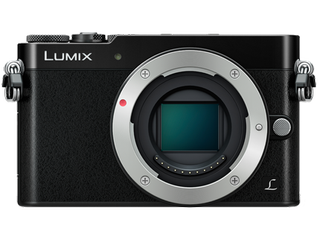
One of the smallest mirrorless cameras on the market, the Panasonic LUMIX DMC-GM5 ($499) is built around the same 16-megapixel sensor as its predecessor but has gone through some changes. The new, and only slightly larger, GM5 is now equipped with an electronic viewfinder but replaces the pop-up flash with a hot shoe and a pint-size accessory flash. This micro four-thirds camera now has a rear thumb dial and additional hard controls squeezed into the back panel, and can now capture video in full HD.
The GM5 doesn't lack for features, but there are other mirrorless cameras that offer the same or better features and performance in a design that's easier to use.
Design: Lilliputian
While the GM5 may not be the smallest ILC mirrorless camera on the market (the Pentax Q-S1 takes the prize for that specification), it's really small, measuring 3.88 x 2.34 x 1.42 inches. It's really lightweight, too, at 9.9 ounces fully loaded with battery pack, SD card and 12-32mm kit lens. The lens is retractable but protrudes just enough to keep the camera out of smaller pockets. Still, the DMC-GM5 is highly portable and fits easily into jacket pockets and purses for take-anywhere convenience.
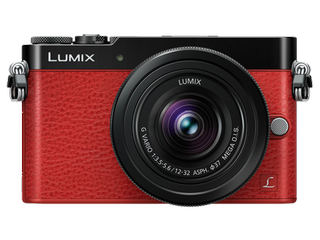
A tiny electronic viewfinder complements the 921K dot, 3-inch touch-screen LCD. Further shrinking the view is the letterbox effect (a dark gray frame surrounds the image). Otherwise, the EVF is clear and usable, particularly when it's too bright outside for the LCD (which also has gray bars on either side) to be visible. Fortunately, the latter works quite well in most situations.
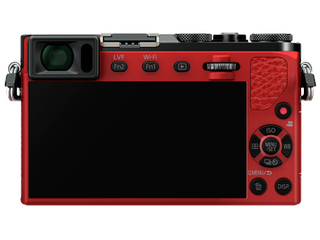
The touch screen is responsive but, like most controls on this camera, the on-screen icons are small and not easy to target with a fingertip. The most functional feature of the touch screen is the ability to quickly target and change focus points (and trigger the shutter, if you want).
The DMC-GM5 is well-made and has a relatively good-size thumb rest on the back. Dedicated hard controls are plentiful with several custom options (additional Fn options can be assigned but are only available on the screen via tiny icons). As I have relatively small hands, the size of the buttons and dial wasn't much of an issue for me. However, in anything less than bright light, it was difficult to read the tiny type or icons that identify the functions of each control. Because of the GM5's small size and controls, photographers with larger hands (or less than perfect eyesight) may have trouble using the camera.
A single SD card slot shares the bottom compartment with the camera's battery but is easy to access. A small, flip-up door on the side of the GM5 is home to its high-speed USB 2.0 and micro HDMI ports. The GM5 is equipped with Wi-Fi but not NFC.
Image Quality: Quite Good
Built around the same 16-megapixel sensor as its predecessor, the DMC-GM5's image quality is surprisingly good for a camera its size. I tested the camera with the 12-32mm f/3.5-5.6 kit lens shooting JPEG + RAW. Shutter-speed priority or aperture-priority exposure modes and the default Standard photo style were used for almost all photos.

The DMC-GM5 produced its best-quality shots outdoors in daylight at low ISOs. Using multi- or center-weighted metering, the Lumix produced accurate exposures, even in high-contrast scenes of this barn against the bright blue sky. More important, the lens produced excellent detail and sharpness along the wooden slats of the building. There was, however, a slight halo along the top edge of the barn.
MORE: Best Mirrorless Cameras - From Beginner to Pro

Dynamic range was good but not exceptional. Shadows tended to be clipped, while highlights, such as the front of this building, failed to exhibit sharp details seen elsewhere in the shot.

Colors were reproduced naturally using the Standard photo style, although there were times when the image — like this late afternoon shot of otherwise brightly colored canoes — could have used a boost from one of the camera's Vivid or custom styles.
Low Light: A Mixed Bag
The GM5's 200-25,600 ISO range is expandable to a low of ISO 100. The camera produced some more-than-respectable images up to ISO 3200.
I captured shots of the Empire State Building using default small JPEGs (an accidental setting) at ISO 3200 and ISO 6400, respectively. In both images, any noise was masked by the underexposed sky going to solid black. Minor noise and softening can be seen on the building's facade and the "For Rent" Sign at the bottom of the image. Had this been shot with a longer lens or closer to the building, the results might have been worse. But the GM5 and the kits lens did a great job from nine blocks away.
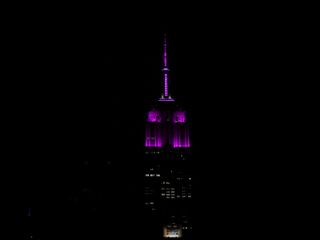
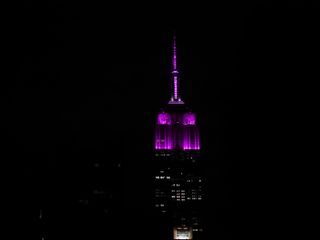
ISO 3200 held up pretty well when shooting a modestly illuminated store- window display late at night. Image noise and softening were most evident on the wood surfaces and in the shadows, but more brightly lit areas generally lacked image noise and retained some areas of sharp detail.
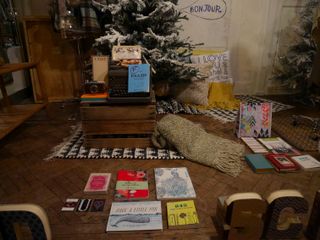
Other scenes shot at ISO 6400 and higher did not fare as well. In JPEGs, noise reduction smudged image detail almost beyond recognition, and the resulting photos looked like watercolor paintings. Keep the dimensions small and they'll look OK online, but they won't be usable in other forms such as prints.
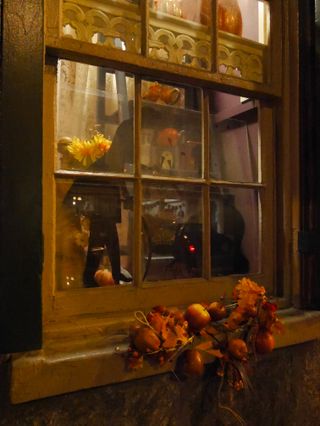

The DMC-GM5 didn't suffer from as much smudging when I took RAW images of the same subjects but, as you can see from the unprocessed RAW photo below, even the best noise-reduction software can't compensate for the high level of noise.

Performance: Somewhat Spritely
The GM5 performed well in some areas but was sluggish in others. Once the lens is unlocked from its retracted position, startup is almost instantaneous. Autofocus is fast and accurate in good light but, understandably, slows in lower light.
Continuous shooting with the mechanical shutter tops out at about 5.8 frames per second with single autofocus (about 5 fps with continuous AF) and can capture up to about 7 RAW + JPEG files at a clip. The monitor and EVF black out during burst mode, though. If you're trying to follow a moving subject, you'll have to guess where your subject is throughout the burst. While the camera is writing the files to the card, you can take a burst of maybe two shots at a time.
The small bundled accessory flash isn't terribly effective but will do in a pinch if you're close to your subject.
It took a while to write the RAW + JPEG files to the card, and there was no red light indicating that data was being written. Therefore, there was no way to know when the process was completed and burst mode was back to its full speed.
A super-high-speed burst mode is available at a top speed of 40 fps using the electronic shutter. It’s only available with lower-resolution JPEG settings, though. You can play back the images in camera continuously or individually. This is a feature that might be useful if you want to photograph the movement of, say, a golfer's swing.
Shutter speeds are available from 60 seconds up to 1/16,000 second. The camera uses the electronic shutter for any speeds above 1/500 second, but image quality doesn't suffer much between the two options. There's no Bulb mode for exposures longer than a minute, however, the camera offers a Handheld Night Shot mode that captures a series of images and combines them into a single photo to help avoid blur from hand-shake.
MORE: Best Cameras
The small accessory flash bundled with the camera isn't terribly effective but will do in a pinch if you're close to your subject. Battery life, at a maximum of 220 shots (if you use only the LCD; it drops to 210 with the EVF), is equally disappointing. But the 12-32mm kit lens' image stabilization works pretty well to counteract handheld camera movement.
Video Quality: Only Average
Fairly standard video options are available on the DMC-GM5, including full HD 1920 x 1080 at 60 and 30 fps; 1280 x 720 at 30 fps; and 640 x 480 at 30 fps in either AVCHD or user-friendly MP4.
You can set the exposure before recording but most settings are locked in once the red movie button is pushed. However, the touch screen comes in handy, because you can use the screen to change focus points.
The camera showed a minor amount of moiré ─ an effect where lines or patterns (like those on the barn door in the video below) seem to move. A bit of shutter roll was also visible, with footage looking a bit wobbly rather than smooth and even.
On the other hand, exposures usually looked accurate, and our video clips were sharply focused for the most part. Image stabilization did not work as well as with still images and the wind-cut filter wasn't terribly effective on a windy day.
Lenses and Accessories
The 12-32mm kit lens is the perfect match for the subcompact GM5 because it adds little weight or bulk. Its 24-64mm equivalent focal range is good for most day-to-day shots but, with the wide range of Micro Four Thirds lenses, there's a good selection of options. However, given the tiny size of the GM5, all but the smallest and lightest lenses negate the benefit of the camera's main attribute — its portability.
Bottom Line
The diminutive Panasonic Lumix DMC-GM5 offers many of the features found in a full-size camera, including an electronic viewfinder and Wi-Fi. But there are better deals when it comes to subcompact, interchangeable lens cameras.
Among cameras of its size, the Canon EOS M3 ($549) has a larger 24-MP sensor, but is slower and has a more limited number of lenses from which to choose. The Nikon 1 J5 ($496) has a smaller sensor and no electronic viewfinder, but has a tiltable touch screen and can shoot video at 1080p/60 fps. If you don't mind going a little larger, the 24-megapixel Sony a6000 with 16-50mm lens ($548) shoots fast ─ up to 11 fps.
Ultimately, the super-small Panasonic GM5 is a good full-featured camera, but it's worth shopping around.
Key Specs
Model Name: Panasonic LUMIX DMC-GM5
Megapixels: 16
Type: ILC/Mirrorless Micro Four Thirds
Price: $699.99 (with 12-32mm f/3.5-5.6 kit lens)
Shots per sec: up to 5.8fps (AFS); 5fps (AFC)
Sensor Type: Micro Four Thirds Live MOS
AF Points: 23
Shutter Speed Range: 1/16,000 (electronic); 1/500 (mechanical)-60 sec. (no bulb)
ISO Range: 200-25,600 (expandable to a low of 100)
Main Video Resolutions/frame rates: full HD 1920 x 1080 at 60 and 30 fps; 1280 x 720 at 30fps; 640 x 480 at 30fps
Video File Format: MP4, AVCHD
Built-in Flash? No (accessory flash provided)
Hot Shoe: Yes
Card Type: SD/SDHC/SDXC
Ports High Speed: USB 2.0, microHDMI, VIERA
Shots Per Charge: (CIPA) 210 (LCD); 220 (EVF)
Wireless Capabilities: Wi-Fi
Image Stabilization Lens: dependent
Dimensions and Weight: 3.88 X 2.34 X 1.42 inches; 0.40 lb (body only); 0.62 lb (fully loaded with battery pack, SD card and 12-32mm lens)
Sign up to get the BEST of Tom’s Guide direct to your inbox.
Upgrade your life with a daily dose of the biggest tech news, lifestyle hacks and our curated analysis. Be the first to know about cutting-edge gadgets and the hottest deals.
Theano Nikitas is a freelance journalist and photographer. She's been writing about photography for more than 20 years, contributing countless reviews of cameras, lenses, accessories and software packages to Tom's Guide. Her work has also appeared in dozens of other magazines and websites, including CNET, DPreview, PopPhoto, Professional Photographer and Shutterbug.
